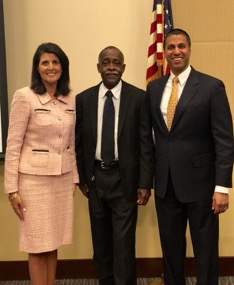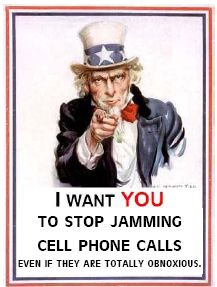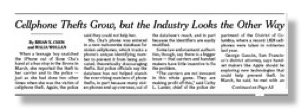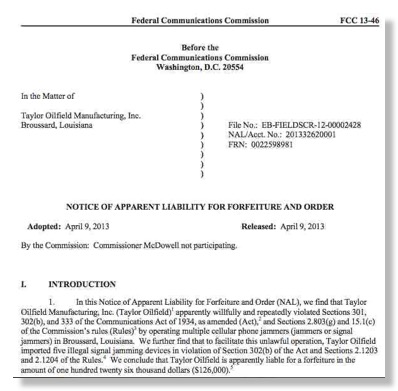Some Spectrum Policy Issues Are Not Economic But Really Life or Death Ones
But the statement was a learning experience. Much of what FCC does is really "economic regulation":
- it affects how much income licensees and regulated entities such as carriers can earn,
- it affects the division of spectrum among industries which indirectly affects their profitability,
- it deals with who can own certain types of licenses and how many of those licenses they can own,
- it affect inter service interference which also affect profitability, etc.
For the purpose of regulating interstate and foreign commerce in communication by wire and radio so as to make available, so far as possible, to all the people of the United States, without discrimination on the basis of race, color, religion, national origin, or sex, a rapid, efficient, Nation-wide, and world-wide wire and radio communication service with adequate facilities at reasonable charges, for the purpose of the national defense, for the purpose of promoting safety of life and property through the use of wire and radio communications, and for the purpose of securing a more effective execution of this policy by centralizing authority heretofore granted by law to several agencies and by granting additional authority with respect to interstate and foreign commerce in wire and radio communication, there is created a commission to be known as the "Federal Communications Commission", which shall be constituted as hereinafter provided, and which shall execute and enforce the provisions of this chapter.
So safety issues should be deep in FCC's DNA. The creation of the Public Safety and Homeland Security Bureau on 9/25/2006 was a positive attempt to get public safety issues away from the main industry focused bureaus of FCC that in many respects like most regulators were captured to some degree by the commercial entities they regulate. Hence WTB was really unable to resolve the long standing NEXTEL/public safety interference issue of the late 1990s and it was only resolved when Nextel came in with a "deal" that public safety entities were willing to agree with - whether or not it was really in the public interest.
(There is an oral tradition in the FCC staff that an engineer of WTB's predecessor was concerned about the possibility of such interference and pressed for protection of public safety as a condition of the original Nextel waiver that permitted their Part 90 licenses to be used for cellular-like technology. However, this was overruled by higher level managers who were focused on the issue of increasing competition in the cellular industry. Hopefully with the creation of PSHSB such decisions will not be so one-sided in favor of commercial interests.)
But there are a few ongoing spectrum policy issues that are really related to life or death issues and that the Commission is not resolving expeditiously. Here are some of them:
Texting & driving. CDC states "Each day in the United States, over 8 people are killed and 1,161 injured in crashes that are reported to involve a distracted driver." While FCC has a webpage entitled "The Dangers of Texting While Driving" and another entitled "Distracted Driving", what is it really doing to decrease the number of deaths associated with this use of FCC licensed technology? Is FCC really paying more attention to CTIA's desires on this issue than on the overall public safety issue? How often are senior FCC officials talking about the death toll resulting from this misuse of radio technology? FCC held a "Distracted Driving Technology Showcase" in April 2013. What has been the progress of implementation of such technology on either a voluntary or mandatory basis? NYTimes recently had a discussion on this issue, but is FCC actually doing anything?
Capt. Robert Johnson (Ret.) SCDC, shot 6 times
as a result of an order given over a contraband
cellphone, with Gov. Haley & Comm. Pai.

Use of contraband cellphones in prisons. This is the subject of Docket 13-111. Note the first 2 digits are "13" indicating that this NPRM was issued in 2013, actually 3 years ago this week. But this NPRM was in turn based in part on a petition filed by the South Carolina Department of Corrections in July 2009 which was never even put out for public comment. (This explains why the NPRM cryptically refers to the SCDC petition by the mysterious code "PRM09WT" rather than the usual RM number.) But the CTIA-favored approach of "managed access" and continuing the absolute prohibition of any jamming by nonfederal users is basing all progress on a quixotic technology. Meanwhile real people die as a result of crimes ordered by incarcerated criminals. Can't FCC give the cellular industry a date certain to show whether managed access under their preferred approach and conditions is an adequate solution for this life or death issue?
Aviation Tower Marking and Lighting Enforcement: One of the more bizarre statements in the nearly $1M study FCC ordered to justify downsizing field enforcement that has never been formally released (but a leaked version was first made available on this blog) is shown below:
Since tower inspection compliance is good, it can be cut back significantly the consultants reason. But tower lighting and marking issues are different than most other FCC compliance issues like frequency and power regulation. As the Coinjock NC helicopter crash incident dramatically showed major screwup can result in multiple deaths. This different than interference which is typical of most Title III technical violations.
Instrument Landing System (ILS)

FM Pirate Interference to Aircraft Navigation: As we have written previously, the FAA's Instrument Landing System has its "localizer" (left/right determination) signal just above the FM broadcast band. ILS receivers have some sensitivity to interference resulting from overloads of two signals that have a certain relationship to the ILS channel used at a given airport and another local FM station. In normal FM licensing this is considered and the threatening frequency is not allowed near an airport. But illegal FM stations do not go through normal licensing! And if the mathematical relationship with another FM station and the ILS frequency is correct, not much power is needed to create interference if the other FM station has a strong signal near the airport. So downsizing enforcement without leaving an alternative mechanism to address this issue is an invitation to aviation safety issues.
Public Safety Interoperability: The January 13, 1982 Air Florida crash in the Potomac River was the beginning of a national dialogue on public safety interoperability. The 9/11 tragedy was another milestone.
There have been improvements since 1982, but has it really been adequate. Now there are a lot of agencies involved in this area and Congress has had a key role in starting FirstNet. But FirstNet is not going to make a big dent in the basic problem for this is what its website says:
FirstNet will enhance public safety communications by delivering mission-critical data and applications that augment the voice capabilities of today’s land mobile radio (LMR) networksWhen the FirstNet network is initially deployed, it will provide mission-critical, high-speed data services to supplement the voice capabilities of today’s LMR networks.
So while the broadband capabilities of FirstNet will be interoperable, today's land mobile radio networks in a myriad of bands will be around for the foreseeable future and will continue to serve as a Tower of Babel as in 1982. Does FCC even talk about this issue?
Basic Problem
Most FCC decision do not involve safety issues and they are basically "economic regulation" in the terms of my former colleague. Thus FCC is structured to deal with such issues.
The few issues that are really matters of life and death do not easily fit into this framework and theus don't get the attention they deserve. The FCC's inability to resolve the issues in Docket 13-111 is a classic ongoing example of this problem. Will FCC ever give the cellular establishment a firm time limit for implementing their preferred solution or will people just continue to die because of this ongoing problem? There are other solutions besides the quixotic "managed access". FCC has moved heaven and earth to meet cellular industry spectrum demands for 4G and 5G, when will the industry either act to decrease the prison contraband problem or stop blocking other solutions?
Cell Industry Finally Acts on Smartphone Theft Prevention
Each device manufacturer and operating system signatory of Part I of this "Smartphone Anti-Theft Voluntary Commitment" agrees that new models of smartphones first manufactured after July 2015 for retail sale in the United States will offer, at no cost to consumers, a baseline anti-theft tool that is preloaded or downloadable on wireless smartphones that provides the connected capability to:
- Remote wipe the authorized user's data (i.e., erase personal info that is added after purchase such as contacts, photos, emails, etc.) that is on the smartphone in the event it is lost or stolen.
- Render the smartphone inoperable to an unauthorized user (e.g., locking the smartphone so it cannot be used without a password or PIN), except in accordance with FCC rules for 911 emergency communications, and if available, emergency numbers programmed by the authorized user (e.g., "phone home").
- Prevent reactivation without authorized user's permission (including unauthorized factory reset attempts) to the extent technologically feasible (e.g., locking the smartphone as in 2 above).
- Reverse the inoperability if the smartphone is recovered by the authorized user and restore user data on the smartphone to the extent feasible (e.g., restored from the cloud).
In addition to this baseline anti-theft tool, consumers may use other technological solutions, if available for their smartphones.
The issue of often violent, sometimes deadly, smartphone thefts has been an active topic in the media and in this blog. Until recently public comments from CTIA focused on the the issue of protecting information on your smartphone by passwords and remote erasing, and paid scant attention to the fact that smartphone were generally stolen for their resale value not their information. This this week’s announcement is a great step forward for the cellular industry paying attention to the “unintended consequences” of their remarkable growth in recent years. Communications technology should enhance life, not threaten it.
CNET reported that New York Attorney General Eric Schneiderman and San Francisco District Attorney George Gascon have concerns about the new CTIA announcement:
"While CTIA's decision to respond to our call for action by announcing a new voluntary commitment to make theft-deterrent features available on smartphones is a welcome step forward, it falls short of what is needed to effectively end the epidemic of smartphone theft. We strongly urge CTIA and its members to make their antitheft features enabled by default on all devices, rather than relying on consumers to opt-in."
(Note to CTIA: CNET is owned by CBS so you might want to boycott them because they agree with San Francisco on this issue.)
But this announce is a good step forward to improving the safety of smartphone users. Even if not all users opt-in, “herd immunity” would apply if the vast majority of users activate the feature. However since there are indications the the electronic serial numbers of many cell phone models are presently changeable as an “undocumented feature”, this will only apply if the new system is robust in the face of tinkering by overseas nerds who stand to make >$100/stolen phone if they can reactivate the phone for sale in their country.
NBC's Today on Stolen Smart Phones - Again
Visit NBCNews.com for breaking news, world news, and news about the economy
As the cellular industry starts the 3rd and last day of CTIA 2013™ in Las Vegas accompanied by all 3 remaining FCC commissioners - who came despite the sequester although no other FCC staff came, the NBC Today show risked joining the City and County of San Francisco on the CTIA boycott list. In the segment shown above, for the second time in a little over 2 months a Today segment by Jeff Rossen highlighted violent thefts of smart phones.
This is another unintended consequence of today’s ubiquitous cell phone use. All new technologies have unintended consequences. While the cell phone industry strives to make positive contributions to our society, economy, and environment it consistently turns a near blind eye to such unintended consequences preferring “solutions” that have little or no impact on industry operations regardless of whether they actually impact the problem at hand. While I can understand a little this tendency of industry, I really don’t understand why FCC tolerates it consistently. Perhaps the new leadership will take a new look?
One real problem that prevents reliable “bricking” of stolen phones is the fact that the IMEI or “serial number” can be changed in many models. As was discussed here earlier, some privacy advocates may favor this, but consumers are ignorant of this design detail that may threaten their life. Making all smart phones reliably “brickable” would enhance public safety. Why doesn’t the cellular industry insist to its suppliers that it be done? If some people really want phones with changeable serial numbers, they should be clearly labeled as such if allowed on the market.
Below is a YouTube “film festival” of violent cell phone thefts so you can see what we are talking about. If you need more, YouTube has plenty!
(This one below is from Brussels, not US)
NY Times: "Cellphone Thefts Grow, but the Industry Looks the Other Way"
The cellular industry does may things very well. It provides high speed reliable service in many parts of our country. It provides amber alert service to help protect children. It helps those suffering from spousal abuse get cell phones for their protection. But the industry also turns a blind eye to the societal problems that are the unintentional consequences of its service. Last year’s New Year’s Resolution post compiled several of these issues. None have shown noticeable improvement.
As in many things, problems not attended to often get worse. The item at the top is an article from the front page of the May 2 New York Times with the title “Cellphone Thefts Grow, but the Industry Looks the Other Way”. One wonders if CTIA and its members will now boycott advertising in theTimes as they have boycotted San Francisco?
The article starts:
When a teenage boy snatched the iPhone out of Rose Cha’s hand at a bus stop in the Bronx in March, she reported the theft to her carrier and to the police — just as she had done two other times when she was the victim of cellphone theft. Again, the police said they could not help her.
Commenting on a record 1,829 cellphones were taken in robberies last year in Washington DC, Police Chief Cathy L. Lanier was quoted as saying, “The carriers are not innocent in this whole game. They are making profit off this.” We guess she was not very moved by CTIA’s John Walls, Vice President, Public Affairs who made this YouTube video last year to show how concerned the industry was about this issue after CTIA felt the Today Show misrepresented their position:
March 2012 Today Show segment on cell phone thefts:
Visit NBCNews.com for breaking news, world news, and news about the economy
CTIA response to Today segment the same day:
While CTIA statements on cellphone theft usually focus on protecting private information on the phone, the large number of thefts raises concerns about violence and contribution to growing crime rates. According to the Times,
In San Francisco last year, nearly half of all robberies involved a cellphone, up from 36 percent the year before; in Washington, cellphones were taken in 42 percent of robberies, a record. In New York, theft of iPhones and iPads last year accounted for 14 percent of all crimes.
Some compare the epidemic of phone theft to car theft, which was a rampant problem more than a decade ago until auto manufacturers improved antitheft technology.
The Times article point out that one complexity that limits owner from making stolen phones nonfunctional by remote controls that the International Mobile Station Equipment Identity of many phones can be hacked, making the stolen phone impossible to identify. On this issue, the cell phone industry is not the only party at fault. Some privacy advocates view this ability to change identity as a good thing. The article states:
Some industry experts say consumers should have the right to modify their phones’ identification features to avoid being tracked.
The right to change the identification is a “pro-privacy measure,” said Seth Schoen, a senior staff technologist at the Electronic Frontier Foundation, a technology-oriented civil liberties group in San Francisco.
While your blogger often agrees with EFF on issues, in this case they have oversimplified the problem. Freedom from being mugged for your smart phone is as important as freedom of your children to go to school without fear of a gunman killing their classmates.
If some people want to change their IMSEIs from time to time for privacy reasons, no doubt a niche market, perhaps such phone should be available and clearly identified as such. Buyers more concerned about muggings - we suspect a much greater portion of the market - could then buy phones with permanent IMSEIs just as we regularly buy cars with permanent VINs. (It would probably be convenient for some to have cars where you can change the license plates by remote control as in James Bond movies but I am not aware of any jurisdiction that allows that.)
In any case, it looks like FCC will have to make a policy decision whether some or all IMSEIs should be permanent as intended. The industry may not be interested in such a proceeding at FCC, but the public safety demands that all options be considered in an open and transparent process.
Jamming Enforcement at FCC Picks Up
On April 9, FCC approved and released two Notices of Apparent Liability (NAL -- effectively fines) for use of cellular jammers. The one shown above was to Taylor Oilfield Manufacturing, Broussard, Louisiana for $126,000. The other was to The Supply Room, Inc., Oxford, Alabama for $144,000. OUCH!!!
(Now before you sell your stock in these companies your should know that FCC is always in a poor position to collect the full amount of such NALs from anyone able to hire an attorney unless the local US Attorney is really interested in getting fully involved. This can be problematical in many parts of the US.)

The NALs have the following text
Signal jamming devices operate by transmitting powerful radio signals that overpower,jam, or interfere with authorized communications. While these devices have been marketed withincreasing frequency over the Internet, with limited exception, they have no lawful use in the UnitedStates. (A footnote clarifies that federal agency use is a separate issue.)
Your blogger fully agrees that since FCC has never authorized any jamming, the import and use of such equipment is illegal. However, they also have the following text:
In order to protect the public and preserve unfettered access to emergency and other communications services, the Act generally prohibits the importation, use, marketing, manufacture, and sale of jammers.
This sentence is a more complicated issue and sounds more like CTIA’s interpretation of Section 333, the subject of CTIA’s 2007 petition that FCC has never acted on. (The petition also contained the issue of “cellular boosters” which was addressed and finally resolved in Docket 10-4 a few months ago.)
The issue of what Section 333 of the communications Act really means is also addressed in GTL’s July 2011 petition which is sitting without action in FCC’s petition “black hole”. Thus CTIA has repeatedly stated that Section 333 forbids FCC from even considering authorizing jamming in any context including nonfederal high security prisons. Somehow CTIA and NTIA have concluded this nonobvious reading of Section 333 does not affect NTIA at all. As GTL points out, this ignores the “inconvenient truth” that Section 305 only exempts federal use from Sections 301 and 303 of the Act and also that the analogous terms of 18 USC 1367, dealing with the special case of satellite jamming and passed contemporaneously with Section 333, explicitly excludes jamming by federal agencies while Section 333 is silent on special treatment of federal users.
But there is no question here that the new FCC NALs are consistent with the law.
Why were these 2 small private companies spending money on cellular jammers? Here is some explanation from the texts of the NALs:
The manager also claimed that Taylor Oilfield utilized the jamming devices to prevent its employees from using their cellular phones while working, apparently following a near miss industrial accident that allegedly was partially attributable to employee cell phone use.
The general manager also confirmed that Supply Room utilized the jamming devices to prevent its employees from using their cellular phones while working.
This is typical of the cellular industry’s lack of attention to the unintended consequences of its technology, In 2005 (the then existing) Motorola commissioned a study by Don Norman on “Minimizing the annoyance of the mobile phone: The Annoyance, Irritation, and Frustration of The Mobile Phone -- A Design Challenge”. Unfortunately today’s cellular industry doesn’t seem too interested in such issues. They do not view them as a “design challenge” rather as legal issues that must be acted on to help their industry.
From Comm Law Blog

All complex new technologies have unintended consequences. As cellular expands the unintended consequences of these systems are becoming more visible. Shouldn’t the cellular industry address those issues more in addition to demanding more spectrum and more jammer enforcement?






![Validate my RSS feed [Valid RSS]](valid-rss-rogers.png)

